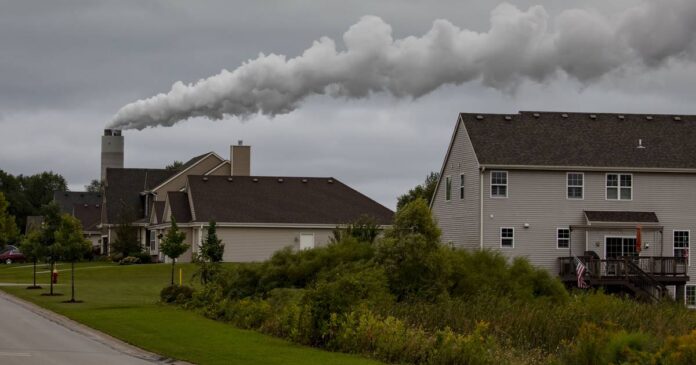Burning coal to generate electricity is on the way out in the United States, but the nation’s long dependence on the fossil fuel took a devastating toll.
A new study determined for the first time that soot pollution from coal-fired power plants is more dangerous than soot from other sources. During the past two decades, the researchers found, coal plant soot contributed to the deaths of at least 460,000 Americans, including 25% of all deaths among Medicare recipients before 2009.
Only Pennsylvania, New York and Ohio recorded more deaths associated with coal plant pollution than the 25,000 deaths in Illinois during the period studied.
An interactive map accompanying the study, published Thursday in the journal Science, reveals glimmers of hope amid the grim statistics.
Deaths attributed to coal plant soot have declined dramatically in recent years as utilities closed scores of their dirtiest plants and cleaned up others — changes prompted by more stringent federal clean air regulations, competition from less expensive gas-fired power plants and legal pressure from environmental groups.
“The fact that they estimated more than 40,000 deaths a year two decades ago and the number is now down to 1,600 a year is a pretty remarkable success story,” said Jonathan Levy, chair of the Department of Environmental Health at Boston University, who wasn’t involved in the study.
Soot, also known as particulate matter, is a byproduct of incomplete combustion and can be formed by chemical reactions between sulfur dioxide emitted by fossil fuel power plants and other compounds in the atmosphere. The type of soot that most concerns public health researchers — PM 2.5 — is so tiny that thousands of the fine particles could fit on the period at the end of this sentence.
Breathing even small amounts can inflame the lungs and trigger asthma attacks. Previous studies have linked soot exposure with heart attacks and premature death.
The latest study comes as President Joe Biden’s administration is moving to tighten a national limit on soot pollution, which in turn could force new regulations on power plants and other industrial sources.
:quality(70)/cloudfront-us-east-1.images.arcpublishing.com/tronc/UGMDBB2K7JDCBCQPWB6NS5N2XI.jpeg)
Utilities fiercely opposed clean air laws for decades. But in one of a series of stark departures from previous debates about anti-pollution rules, the chief trade group for investor-owned utilities appears to be more concerned about how the Biden proposal would be implemented rather than opposing it outright.
“The electric industry has significantly reduced air pollutants such as (sulfur dioxide), (nitrogen oxide), and hazardous air pollutants such as mercury,” Sarah Durdaller, a spokeswoman for the Edison Electric Institute, said in an email. “Additional emissions reductions are expected as the industry continues its clean energy transition.”
:quality(70)/cloudfront-us-east-1.images.arcpublishing.com/tronc/PSJOGU6D5RHQNPSI2MPJQRLRXA.JPG)
A Chicago Tribune review of the new study’s interactive map shows why former President Donald Trump’s attempts to gut the U.S. Environmental Protection Agency, roll back clean air laws and leave regulatory decisions to the states could have made it difficult to continue reducing deaths from coal plant pollution.
For instance, Illinois coal plants were responsible for more deaths associated with soot-related deaths in Wisconsin and Iowa than coal plants in the two other states, the researchers found.
At the same time, the study shows, several Wisconsin coal plants were responsible for more Illinois deaths than those in Wisconsin.
While researchers linked most of the Illinois deaths to coal plants within the state, others as far away as North Carolina, North Dakota and Texas contributed.
“Pollution doesn’t respect state boundaries,” said the study’s lead author, Lucas Henneman, a professor of environmental engineering at George Mason University.
The EPA found similar dynamics at work earlier this year when it took a new look at smog, another type of air pollution.
Chicago and the rest of Cook County are the nation’s worst neighbors when it comes to smog, the EPA concluded in research supporting its proposed “good neighbor rule” pending before the U.S. Supreme Court.
Henneman and his colleagues based their analysis on emissions data reported to the EPA and a massive database of Medicare enrollees. They used well-tested computer models to track how emissions from individual coal plants contributed to soot-related deaths in every state.

Afternoon Briefing
Weekdays
Chicago Tribune editors’ top story picks, delivered to your inbox each afternoon.
In an editorial published in the same issue of Science, researchers at Yale and Columbia said Henneman’s study showed that reducing coal plant pollution has been more beneficial than previously thought.
Though PM 2.5 can’t be seen with the naked eye, the spread of smoke from Canadian wildfires during the summer provided a vivid example of how soot pollution can make the air so dirty that even healthy people have trouble breathing, said Francesca Dominici, a Harvard biostatistics professor who contributed to the study and previously linked soot exposure to COVID-19 deaths.
Bruce Nilles, former director of the Sierra Club’s Beyond Coal campaign, said the declining number of deaths associated with coal plant pollution is a result of a long battle that led utilities to close or announce the retirement of 374 power plants that burned the fossil fuel.
About a fifth of the nation’s electric generation now comes from coal plants, down from more than half a decade ago.
All but two coal plants in Illinois are expected to be closed by the end of the decade. Eight that already have closed in and near Chicago were responsible for 5,660 soot-related deaths between 1999 and 2020, the new study found.
“We’ve come a long way,” Nilles said. “But this study shows there are still some big problems out there, and that means we need the EPA to step in and ensure everyone is protected.”



